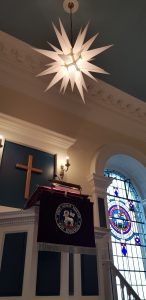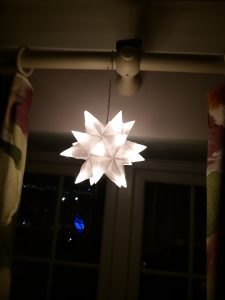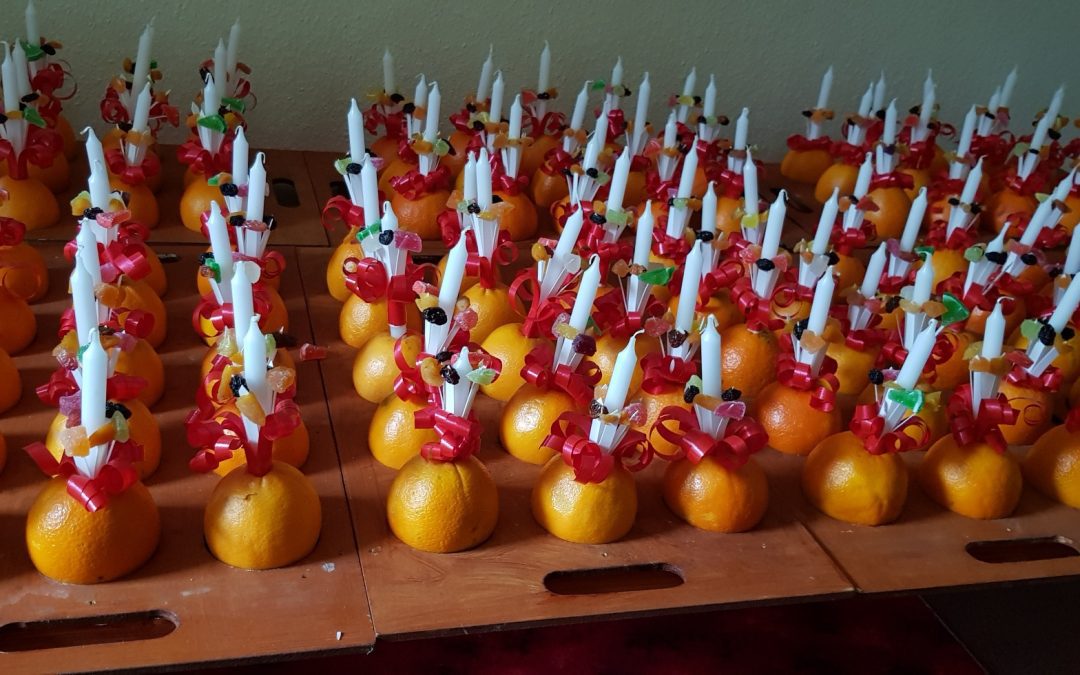In this season of Advent I am going to focus on three Moravian traditions. Most certainly Elizabeth will have made both a Christingle and a Moravian star during her two years at Fulneck Moravian School. Along with the other pupils, she will have attended a Christingle service, just like the pupils today, and will have seen the Moravian star shining brightly. These two wonderful Christmas traditions now appear around the world, bringing light and hope even in the darkest times.
Today a Moravian star shines throughout Advent from the Fulneck Bell Tower and one hangs in the church, above the pulpit. On the first Sunday of Advent the children will have sung the Hosanna Chorus, which they will also have sung on Palm Sunday. Today it is still sung in Moravian churches around the world on these two days.
 A Moravian Star shining in Fulneck Church
A Moravian Star shining in Fulneck Church
Christingle
The idea of the Christingle began in 1747 at a German children’s service. To illustrate his words the minister handed each child a candle tied with a red ribbon.
No one knows for certain when the word “Christingle” was first used or from what it is derived. Various suggestions have been made. One is that it comes from the old Saxon word “ingle” (fire), meaning “Christ-fire or light.” Another is that it derives from the German “Engel” (angel), meaning “Christ-angel,” or it may derive from the German “Kind” (child), meaning “Christ-child.”
The symbolism gradually developed, and today in the Moravian Church in the British Province, the Christingle consists of an orange, representing the world, with a lighted candle to represent Christ, the Light of the World. Nuts, raisins and sweets on cocktail sticks[1] around the candle represent God’s bounty and goodness in providing the fruits of the earth. Red paper, forming a frill around the base of the candle, reminds us of the blood of Christ shed for all people on the cross at Calvary.
At Fulneck church we normally have the joy of making nearly 250 Christingles and welcoming so many people that the church is full. Everyone holding up a lit Christingle is indeed a beautiful sight on a dark winter’s evening.
The Moravian Star
The Moravian Star was first created by a teacher at the Moravian School in Niesky, Germany. He used the star to explain geometry, as it has 17 quadrangular and 8 triangular points. The mathematical name for it is Rhombicoctahedron: I challenge you to say that quickly after some mulled wine.
One of the graduates from the school, Pieter Verbeek, opened a bookshop in 1880 and used the star to decorate his shop. His son went on to establish a factory to make the stars and they sold all over the world until the second World War. The factory was destroyed and then taken over by the East German government. It was returned to the Moravian Church and is now once more producing stars[2].
I had mentioned the star to my German friend and told him I was hoping to buy one. So, imagine my surprise when I received a parcel from him – a star made by a friend of his mum. The tradition lives on and this star, like in previous years, shines out from our front window.

My Moravian star shining brightly
Hosanna
The Hosanna Chorus is often sung by children, particularly at the start of Advent and on Palm Sunday. Below is a link to a Moravian youth group continuing this tradition. Now in Moravian churches around the world, you will find that adults also enjoy singing this chorus.
Thank you for reading my posts. Due to the many folks who have been kind enough to buy the book and to donate at my talks I have sent off a large donation to the two charities associated with Elizabeth: Moravian Women’s Association and Futures for Women. Please pass my details to anyone who may be interested in organising a talk.
Finally, may I wish you each a happy Christmas and a peaceful New Year.
[1] Or something less dangerous! Traditionally, goose quills were used.
[2] https://mybrilliantstar.com/collections/all-products At this site you can purchase the star and find out more about its history and production.


Recent Comments